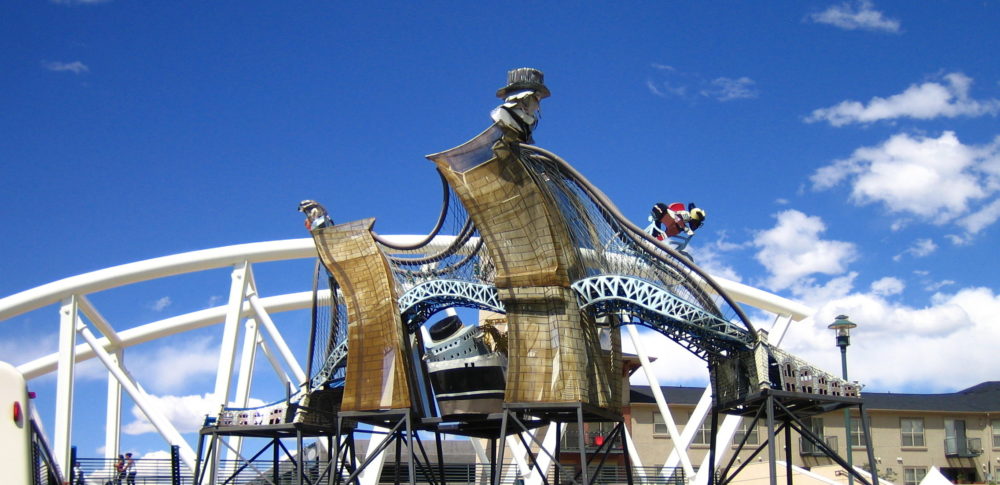
Artist: Red Grooms
Year: 1977
Dates: b.1937, Nashville, TN
Materials: Painted steel
Dimensions: 16′ x 31′ x 12.5′
About Brooklyn Bridge
History: Construction for the Brooklyn Bridge in New York began in 1869 and presented many technical challenges throughout the project. No other bridge of its size existed at the time. John Augustus Roebling (1806-1869) designed the Brooklyn Bridge. He was born in Germany and educated there as an engineer, but immigrated to the United States in 1831. He is one of the most important engineers of his time, due to his development of the modern suspension bridge.3 After John Augustus Roebling died, his son, Washington Roebling, was responsible for realizing his father’s ideas. When the Brooklyn Bridge finished construction in 1883, it was the first bridge to connect the island of Manhattan to Brooklyn.
In Red Grooms’ Brooklyn Bridge, the artist pays homage to the original designer of the bridge. John Augustus is the large bust with the top hat. Washington and Emily Warren Roebling are the couple on the other side of the bridge. He also incorporates everyday elements like cyclists, pedestrians, and a large ship that invite the viewer into his visually chaotic city. Grooms is an astute observer of modern life and culture, and thus is able to create a strong sense of place within his art. With his humorous, yet naïve style, Grooms constructs an animated, mixed media sculpture, overwhelming the viewer with a visual explosion of pop culture. Red Grooms’ Brooklyn Bridge is part of a much larger piece called Ruckus Manhattan (1976). Red Grooms is an American painter, sculptor, installation artist, draughtsman, performance artist, and filmmaker, and is a continual pioneer in expanding traditional categories of art.4 He attended the Art Institute of Chicago, New School for Social Research, and Hans Hofmann School on Cape Cod.
About Red Grooms
Red Grooms was born in Nashville, Tennessee in 1937. He studied at the Art Institute of Chicago and the New School for Social Research, New York. In the 1950s Grooms moved to New York City to immerse himself in the art scene. For nearly fifty years Grooms has combined color, vibrancy, and a generous dose of self-deprecating humor to produce art in all media that provokes and delights. He pokes fun at the icons of American politics, entertainment, the art world, while paying homage to his subjects at the same time. No artist since Honoré Daumier has had a greater understanding of humor or a more direct connection to his audience. In return, Grooms has earned the public’s unqualified admiration and appreciation.
As a painter, sculptor, printmaker, filmmaker and theater designer Grooms’ career to this point has been prolific. His graphic works alone includes an array of art forms including etchings, lithographs (two and three-dimensional), monotypes, woodblock prints and spray-painted stencils. Throughout the late 1980s and the mid 1990s Grooms devoted himself to a series of prints and three-dimensional works called New York Stories for which he is well known and admired.
The artist’s work can be found in museums and private collections worldwide including the Art Institute of Chicago, Chicago, Illinois; Fort Worth Museum of Contemporary Art. Fort Worth Texas; Hirshhorn Museum and Sculpture Garden, Washington, D.C.; The Metropolitan Museum of Art, New York, New York; Moderna Museet, Stockholm, Sweden; Museum of Contemporary Art, Los Angeles, California; Museum of Modern Art, New York, New York; and the Nagoya City Museum, Nagoya, Japan.
Biographical information courtesy of Ro Gallery
